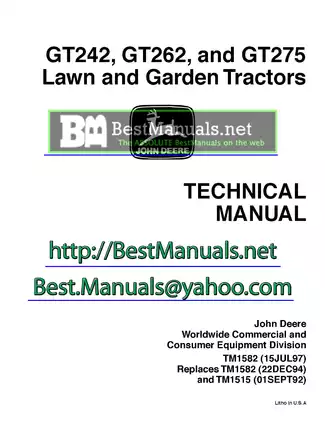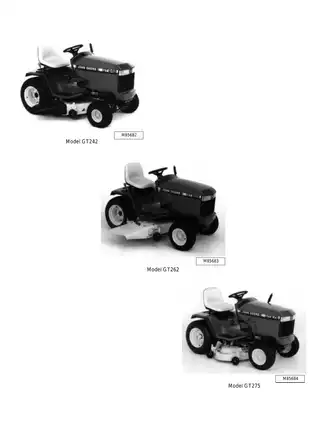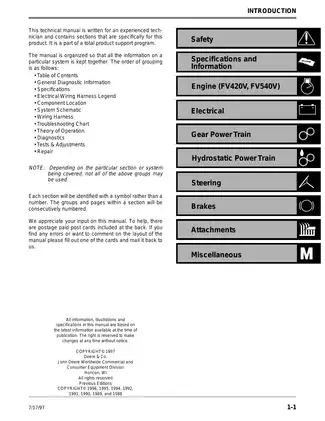John Deere GT242, GT262, GT275 Technical Service Manual for Lawn and Garden Tractors
Product Gallery

Sample pages from the John Deere GT242, GT262, GT275 Technical Service Manual for Lawn and Garden Tractors manual



Purchase Information
John Deere GT242, GT262, GT275 Technical Service Manual for Lawn and Garden Tractors - Technical Specifications
- File Size:
- 9.93 MB
- File Type:
- Language:
- English (some of our manuals are multilingual)
- Pages:
- 429
- Printable:
- Yes
- Estimated Download Time:
- 0.2 Minutes
- Delivery Format:
- Digital (PDF) - Instant Access
- Category:
- Garden Tractor
- Brand:
- John Deere
John Deere Models and Parts Covered in this Garden Tractor Manual
- GT242 (1997)
- GT262 (1997)
- GT275 (1997)
John Deere John Deere GT242, GT262, GT275 Technical Service Manual for Lawn and Garden Tractors - Complete Manual Information
John Deere GT Series Technical Manual (Lawn and Garden Tractors)
This comprehensive technical manual is designed specifically for the John Deere GT242, GT262, and GT275 Lawn and Garden Tractors. Featuring detailed instructions, diagrams, and specifications, this product is essential for both professional technicians and DIY enthusiasts aiming to maintain and repair their tractors efficiently.
What's Inside
General Information
- Overview of the GT242, GT262, and GT275
- Safety recommendations for service
Technical Specifications
- Engine specifications (Kawasaki FC420V and FC540V)
- Electrical system identifications
- Fuel system designs and parameters
Diagnostic Information
- Diagnostic flowchart cues
- Troubleshooting common issues with engines and electrical systems
Repair Procedures
- Step-by-step guides for engine disassembly, including camshaft, piston, and crankshaft procedures
- Governor and carburetor adjustments
- Starter, fuel pump, and PTO clutch evaluations
Torque Specifications
- Critical tightening specs for all components
Maintenance Recommendations
- Regular maintenance intervals and schedules
- Detailed service instructions to prolong engine life
Wiring Diagrams
- Clear visual references for all electrical connections and components
Use this manual to ensure your John Deere GT tractors are in peak operational condition and ready for any gardening task. Regardless of whether you’re a skilled technician or a novice gardener, this guide provides the necessary support to tackle repairs effectively and enhance your understanding of your equipment
Download Instructions for John Deere Garden Tractor Manual
Frequently Asked Questions - John Deere Garden Tractor Manual
What does this John Deere manual cover?
This comprehensive service manual covers detailed repair procedures, maintenance schedules, troubleshooting guides, and technical specifications for John Deere GT242, GT262, GT275 Technical Service Manual for Lawn and Garden Tractors. It includes information for the following models: - GT242 (1997) - GT262 (1997) - GT275 (1997).
Is this manual suitable for beginners?
Yes, this John Deere manual is designed for both professional technicians and DIY enthusiasts. It includes step-by-step procedures with clear illustrations and safety guidelines for Garden Tractor maintenance and repair.
What file format will I receive?
You will receive this manual as a PDF file (9.93 MB), which is compatible with all devices. The manual is fully searchable and printable for your convenience.
How quickly can I access the manual after purchase?
You'll receive instant access to your John Deere Garden Tractor manual immediately after payment completion. The download link is valid for 3 days, with lifetime re-download guarantee.
Does this include hydraulic system information?
Yes, this equipment manual covers hydraulic system operation, maintenance procedures, and troubleshooting for your John Deere machinery.
Can I print specific sections of the manual?
Absolutely! This digital manual allows you to print any section you need, from individual pages to complete chapters, making it perfect for workshop use.
John Deere John Deere GT242, GT262, GT275 Technical Service Manual for Lawn and Garden Tractors Customer Reviews and Feedback
Read what our customers say about this John Deere Garden Tractor manual and share your own experience.
Add Comment
This policy contains information about your privacy. By posting, you are declaring that you understand this policy:
- Your name, rating, website address, town, country, state and comment will be publicly displayed if entered.
- Aside from the data entered into these form fields, other stored data about your comment will include:
- Your IP address (not displayed)
- The time/date of your submission (displayed)
- Your email address will not be shared. It is collected for only two reasons:
- Administrative purposes, should a need to contact you arise.
- To inform you of new comments, should you subscribe to receive notifications.
- A cookie may be set on your computer. This is used to remember your inputs. It will expire by itself.
This policy is subject to change at any time and without notice.
These terms and conditions contain rules about posting comments. By submitting a comment, you are declaring that you agree with these rules:
- Although the administrator will attempt to moderate comments, it is impossible for every comment to have been moderated at any given time.
- You acknowledge that all comments express the views and opinions of the original author and not those of the administrator.
- You agree not to post any material which is knowingly false, obscene, hateful, threatening, harassing or invasive of a person's privacy.
- The administrator has the right to edit, move or remove any comment for any reason and without notice.
Failure to comply with these rules may result in being banned from submitting further comments.
These terms and conditions are subject to change at any time and without notice.
Comments (1)